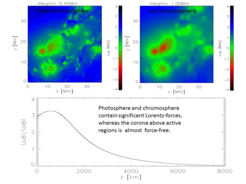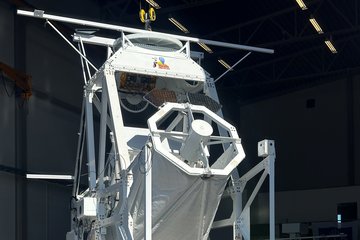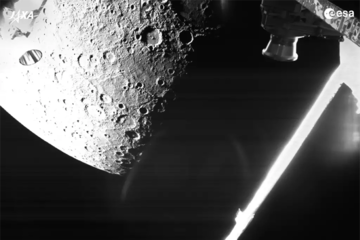Study time series of magneto-hydro-static equilibria in solar active regions and the quiet Sun
In our group we have extensive experience of studying sequences of stationary equilibria of the solar corona above active regions with force-free models as well as the modelling of the quiet Sun and coronal holes with potential field models (potential fields are a special class of current-free force-free fields). While the solar corona contains a low plasma-beta (the ratio of plasma pressure and magnetic pressure) and can be modelled under the assumption of a vanishing Lorentz force, this is not the case at lower altitudes in the solar atmosphere, the photosphere and chromosphere. As seen in the figure, the plasma-beta may vary over several orders of magnitudes in these regions. Consequently, these lower layers of the solar atmosphere are very challenging to model, because both the magnetic and plasma forces have to be taken self-consistently into account. This can be done by magneto-hydro-static (MHS) models developed in our group. We have created two versions of the magneto-hydrostatic-codes:
- A nonlinear MHS-code based on an optimization principle. This code requires photospheric vector magnetograms as a boundary condition, which are only available with sufficient accuracy in active regions.
- A linear MHS-code. This code requires only vertical magnetic field measurements as a boundary condition, and three free model parameters have to be specified by a comparison with chromospheric and coronal observations. This code can be applied to active regions, the quiet Sun, and coronal holes. We have recently (see publication 7 in the list below) written a program, which computes the three free model parameters automatically from a vertical magnetogram and coronal or chromospheric images.
Within this project we aim to study the evolution of the magnetic field and plasma in the photosphere and chromosphere, and their connection to the corona. The output of the codes are 3D-models of the magnetic field, plasma pressure, density, and electric currents. These models allow to study the temporal evolution of the magnetic field and plasma structure in active regions, the quiet Sun, and coronal holes. The models will help to guide the analysis of imaging and spectral observations taken with various instruments on board the solar dynamics observatory, Hinode, Solar Orbiter (spacebased) and DKIST (groundbased).
Key questions are:
- How are energy and matter supplied from the lower solar atmosphere into the corona?
- At which heights does the solar atmosphere become force-free?
- How does the Lorentz force affect the magnetic structure?
- How do chromospheric magnetic field measurements compare with the MHS-model?
- What is the role of field-aligned and transverse currents?
Further reading:













